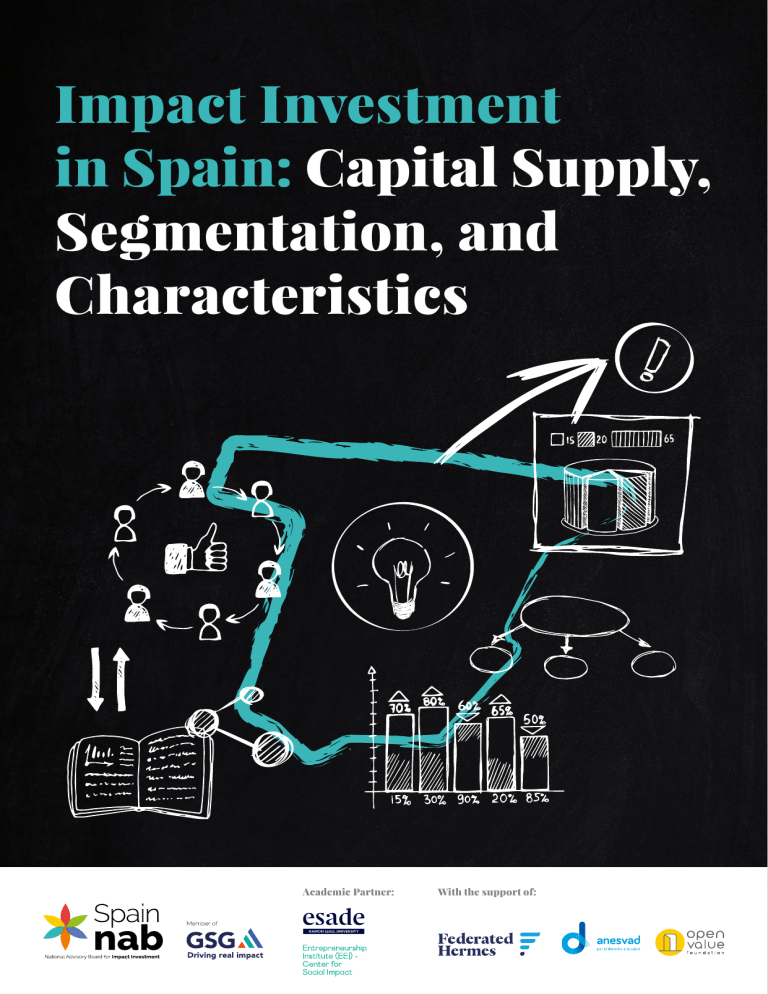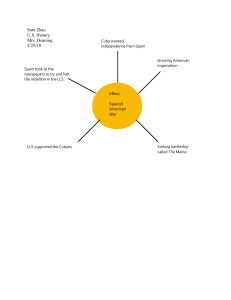
Impact Investment in Spain: Capital Supply, Segmentation, and Characteristics Academic Partner: With the support of: 2 3 Foreword Dear readers: In June 2019, when we joined the Global Steering We have segmented the market based on the Group for Impact Investment (GSG), we started off impact classification system provided by the Impact with an impact investment figure close to EUR 90 Management Project (IMP), using a survey of our million from private equity impact funds; back then, own design, aligned with the European Venture Authors we made a commitment to quadruple the size of the Philanthropy Association (EVPA), which was sent to market in two years, and we have exceeded this goal, actors involved in the supply of impact capital in Lisa Hehenberger Associate Professor, Department of Strategy and General Management, Esade Director, EEI – Esade Center for Social Impact in the context of a global growth trend that we believe Spain. In this process, a committee of experts in impact is long-lasting. investing has helped to design and distribute the survey Guillermo Casasnovas Postdoctoral Researcher, EEI – Esade Center for Social Impact Suzanne Jenkins Researcher and Business Case Developer, EEI – Esade Center for Social Impact This project has been led by SpainNAB with the technical support of: and to provide guidance on topics of debate. However, building a strong impact investment market in our country, requires a deep understanding The impact of this study goes beyond our domestic of the supply of capital, the different players that market, as it has shaped the effort to harmonize provide it, and the characteristics that define their impact investment figures across Europe, within the strategies. This study is part of recommendation 5 framework of the GSG, with the goal of creating a of SpainNAB’s action plan: create knowledge and common market and reinforcing the importance of market infrastructure for an impact economy. impact investment in the EU to advance the creation of a more just and resilient society. Jose Luis Ruiz de Munain Executive Director, SpainNAB The recent EU Sustainable Finance Disclosure Laura Blanco Director of Knowledge and Outreach, SpainNAB Regulation (SFDR), which groups very diverse We want to express our gratitude to all the entities sustainable and impact investment products within that have participated in the survey, the members of the same category, together with the disparity the expert committee and to Federated Hermes, of criteria for sizing impact investing as part of Fundación Anesvad, and Open Value Foundation, sustainable investing, have only underscored the without whose support this study would not have importance of this study to preserve the integrity of been possible. this burgeoning market. Let’s keep going! This document is a translation of some parts of the original report written in Spanish. The full-length original version is available here: https://spainnab.org/publicaciones Jose Luis Ruiz de Munain Executive Director, SpainNAB With the support of: Lisa Hehenberger Associate Professor, Department of Strategy and General Management, Esade Director, EEI – Esade Center for Social Impact Impact Investment in Spain: Capital Supply, Segmentation, and Characteristics EXECUTIVE SUMMARY 4 Executive summary 4. MULTIPLICITY OF SOURCES AND DESTINATIONS OF FINANCING Individual investors are the main source of capital for impact investment (69%), via their deposits and checking accounts in ethical and social banks. They are followed by institutional investors (10%), foundations Impact investors seek to generate a measurable social or environmental impact, in addition to a financial return. In this study, we have measured the size of the sector in Spain, including impact financing as part of it; we have segmented it using several variables based on the Impact Management Project (IMP); and we have analyzed the main characteristics of each segment. As of December 2020, the Spanish impact investment market had an estimated EUR 2.378 billion of assets under management (AUM). Below is a summary of the main conclusions. 1. MARKET DIVERSITY BEYOND PRIVATE EQUITY FUNDS Impact investment goes beyond private equity impact funds (which include venture capital funds and other funds that invest in the capital of private companies), which represent only EUR 536 million of the EUR 2.378 billion managed by the sector in 2020. These impact funds have pioneered practices such as impact measurement, impact-related management incentives, and tailored early-stage financial support, and they have taken the lead in recent years to promote and strengthen the sector. However, they are joined by other types of entities, such as ethical and social banking, which has a long history in the market and manages EUR 1.521 billion in impact investment, and foundations, which manage EUR 242 million. This diversity of players means that the capital supply comes from different sources and can better meet the financing needs of different types of companies and organizations 2. RAPID GROWTH AND HIGH EXPECTATIONS Impact investment is clearly growing, with an annual rate of 26% compared to 2019, driven by private equity funds, up 34%. The sector expects significant growth to continue in 2021; many investors are confident that it will remain in the double digits. Furthermore, a third of private equity funds expect to increase their (10%), and the public sector (7%). Looking specifically at private equity funds, the main investors are institutional (29%), followed by family offices (16%), high-net-worth individuals (HNWI) (14%), public sector funds (15%), and EU funds (9%). This reflect that impact investing is a type of investment that more and more actors are considering. The destination of impact investment is also diverse, in terms of geography (although approximately 50% is focused on Spain) and stage of development of the financed companies (with preference for growth phases over incubation). 5. PLURALITY OF INSTRUMENTS AND EXPECTATIONS Most of the impact investment is channeled through private debt and equity (75% and 25% respectively), with some variation in expected returns (somewhat higher in private equity funds), in the period (the most common is 4 to 6 years), and in the size of the investments (EUR 1 million euros on average, although smaller for ethical and social banking and foundations). 6. IMPACT MEASUREMENT, WITH A NEED TO MOVE TOWARDS IMPACT MANAGEMENT Virtually all of the vehicles included in the study measure their social impact. Some do it with standardized tools (47%) while others use only their own tools (45%), but few actors carry out external audits of their measurement systems. Some investors already use impact measurement throughout the investment process, from defining their objectives to monitoring and evaluating their investments. However, many more use impact measurement indicators to communicate with different stakeholders, indicating that there is still a long way to go from impact measurement to impact management. Finally, investment has flowed to organizations targeting a variety of beneficiaries and Sustainable Development Goals. AUM by more than 50%, due to the expansion of existing funds and the creation of new funds. 3. ADDITIONALITY IN DIFFERENT DEGREES We segmented the market based on the contribution of investors to their social and/or environmental impact objectives. The majority of the AUM is managed by actors who not have the intention to generate positive impact but also engage actively to improve the impact of the investee, but who do not participate in new or undersupplied capital markets or provide flexible capital. This segment corresponds, to a large extent, to ethical and social banking. However, there is a significant number of investment vehicles, among which private equity funds stand out, that finance undersupplied markets, investing in companies that would find it difficult to obtain similar financing in the marketplace. Finally, there is a series of private equity funds and foundations that, in addition to engaging actively and targeting undersupplied capital markets, do offer flexible capital, assuming a higher risk or a lower financial return than the market. Impact Investment in Spain: Capital Supply, Segmentation, and Characteristics Impact Investment in Spain: Capital Supply, Segmentation, and Characteristics 5 METHODOLOGY 6 Methodology 7 Impact classes. We rely on the IMP methodology to understand and classify the different types of investment impact. The impact classes are defined by the combination of two dimensions: the impact of the underlying asset (the company or project in which the investor invests), and the strategies that investors use to contribute to this impact. In this study, each respondent’s activity was classified, by investment vehicle, using questions designed to understand these two dimensions. The impact of the underlying asset has been used as an This report presents data from actors in Spain that carry out or manage impact investing, obtained through inclusion criterion; only vehicles that invest in class C assets have been included. The investor’s contribution a survey administered between January and April 2021. The survey asked about the volumes of capital has been used as a variable to segment the market. managed and investments made in 2020, plans for 2021, investment strategies, and impact measurement and management practices. Social enterprises are those organizations seeking to contribute to the improvement of certain social challenges through a sustainable business model, regardless of their legal form2. GOALS The main goal of the study was to take a snapshot of the state of the capital supply for impact investment in Spain, to establish a basis for observing its evolution in the coming years. The specific objectives were to quantify and segment the sector and analyze its main characteristics. DEFINITIONS AND INCLUSION CRITERIA IMP IMPACT CLASSES The definitions and inclusion criteria were established through a benchmark with those used in other studies carried out by leading international organizations - the GIIN, the International Finance Corporation (IFC), the EVPA, and the IMP - and by the GSG-affiliated national advisory boards in France, Italy, and Germany. They were also discussed and reviewed with the help of an Expert Committee made up of 12 representatives from different market sectors. The Impact Management Project (IMP) defines Figure 1: Impact of underlying assets impact classes that combine two dimensions: the impact of the underlying asset (the company Impact investment is defined as an investment that intentionally seeks a measurable social or environmental impact, in addition to a financial return. 1 Only respondents who stated that they invested or managed investments with the intention of generating a positive social or environmental impact, along with a financial return, were included. The third attribute, measurement, has been used as a research variable rather than to exclude respondents. or project in which the investor invests), and the strategies that investors use to contribute to this Act to avoid harm impact.3 The impact of the underlying asset is defined Benefit stakeholders according to classes A, B and C. In class A, Impact investment supply is defined as the supply of capital that companies with impact can access to meet their financing needs and that meets the intentionality and return criteria. Accordingly, bank financing that is directed to companies with impact has been included along with other investment activities. Following this same definition, microfinance activity has been included only when the microcredits were intended for social enterprises; in general, microfinance organizations are considered to be social enterprises in which impact investors invest. the invested projects “act to avoid harm” on people and/or the planet. In class B, they seek to “benefit stakeholders” by generating general positive effects. In class C, they “contribute to solutions” by addressing significant social Contribute to solutions Generate a significant positive change for underserved people or the planet or environmental challenges and generating positive effects specifically for underserved Spanish market. To avoid duplication of data and to study investment and impact management strategies, people or the planet. Source: IMP we have focused on the actors based in Spain who manage direct investments in companies with impact. In other words, capital that is managed in Spain is included, whether or not the origin or destination of the investment is national. 1. Hehenberger, L.; Casasnovas, G.; Urriolagoitia, L.; Blanco, L.; Ruiz de Munain, J. L. (2019): Hacia una economía de impacto: Recomendaciones para impulsar la inversión de impacto en España. SpainNAB. Impact Investment in Spain: Capital Supply, Segmentation, and Characteristics 2. San Salvador, C.; Casasnovas, G.; Hehenberger, L. (2021): Necesidades de financiación de las empresas sociales en España. Esade Center for Social Impact y Open Value Foundation. 3. The IMP Impact Classes of Investment available here: https://impactmanagementproject.com/investor-impact-matrix/ Impact Investment in Spain: Capital Supply, Segmentation, and Characteristics METHODOLOGY 8 METHODOLOGY 9 SURVEY DISTRIBUTION The survey was distributed to all actors known or thought to be undertaking or managing impact investing, Investor contribution is ranked from 1 to 6, depending on which of the following strategies are identified by SpainNAB, Esade, and the Expert Committee, and through social media. We approached employed to support impact generation: asset owners and intermediaries who manage investments, including private equity funds, microfinance funds, investment funds in listed assets, foundations, traditional financial and ethical banking institutions, • Signal that impact matters: the investor opportunity. This may involve taking on microfinance institutions, family offices, business angels, crowdfunding platforms, international development chooses not to invest in or to favor certain additional complexity, illiquidity, or the agencies and public financing entities, among others. investments considering that, if all investors perception of disproportionate risk. did the same, it would ultimately lead to a DATA COLLECTION AND CLEANING ‘pricing-in’ of effects on people and planet • Provide flexible capital: the investor The main data collection tool was an online survey. Respondents who indicated that they managed direct by the capital markets. Some people think recognizes that certain types of enterprises investments were asked to list the different funds or other impact investment vehicles that they managed, of this concept as an “alignment of values.” will require acceptance of lower risk-adjusted and most of the questions collected data about each vehicle. Follow-up calls were made to many of the return, in order to generate certain kinds of respondents to clarify possible inconsistencies, but in no case was the data audited. • Engage actively: the investor leverages impact. For example, creating a new market expertise and networks to improve the social/ for previously underserved populations may POPULATION environmental performance of businesses. require patient capital that cannot offer a The following table indicates the number of actors who received and completed the survey and who met commercial return. the different inclusion criteria. A total of 38 actors met all the criteria, while more than 25 actors participated in impact investing but could not be included because their investment is indirect or because they do not • Grow new or undersupplied capital manage it in Spain. markets: the investor participates in new or previously overlooked opportunities that offer an attractive financial and impact Table 1: Survey population Criteria Figure 2: Investor contribution + Engage actively Signal that impact matters + Grow new or undesupplied capital markets + Provide flexible capital C1 C2 C3 C4 C5 C6 Number of respondents Received the survey 145+ Completed the survey 77 + Carry out or manage impact investment 69 + Manage investment in Spain 62 + Direct investment 43 + Investment is Class C (contribute to solutions) 38 In the survey, each actor was asked to identify the different impact investment vehicles that he manages, and then most of the questions were asked about each vehicle. Therefore, most of this report looks at investment vehicles rather than actors. Source: Based on IMP definitions Impact Investment in Spain: Capital Supply, Segmentation, and Characteristics Impact Investment in Spain: Capital Supply, Segmentation, and Characteristics 10 11 Acknowledgments We want to thank all the people and organizations that have supported us in carrying out this study and, in a special way, to the members of the Committee of Experts, to the organizations that have helped us in the dissemination of the survey and investors who have dedicated time and effort to answer the questions. COMMITTEE OF EXPERTS: Agustín Vitórica, GAWA Capital Ángela Alférez, Asociación Española de Capital, Crecimiento e Inversión (ASCRI) Carlos Capela, Federated Hermes Eduardo del Río, Asociación Española de Fundaciones (AEF) Emilio Ayanz, CREAS Fabrizio Ferraro, IESE Business School Gorka Goikoetxea, Fundación Anesvad Javier Garayoa, Foro Español de Inversión Sostenible (SpainSIF) José Carlos Villena, COFIDES Marcel Abad, Oportunitas María Ángeles León, Open Value Foundation Oscar Muguerza, Laboral Kutxa STUDY PARTICIPANTS:4 • HOGAR SÍ • Open Value Foundation • Impact Bridge Asset Management • Oxfam Intermón • Federated Hermes • Arcano Partners • Fiare Banca Etica • Impact Partners Iberica • PC30 • AXIS Participaciones Empresariales • Fundación Anesvad • inuit Fundación • Plan Asociado de UGT • Fundación Antonio Aranzábal • Inversiones Financieras Perseo (Iberdrola) • Portocolom AV • Bridgestone Hispania Pensión, FP • Fundación BBK • Investir&+ • Fundación CODESPA • Itzarri EPSV de Empleo • CaixaBank • Fundación Daniel y Nina Carasso • La Bolsa Social • Laboral Kutxa • Fundación EKI • Santalucía Asset Management • Magallanes Value Investors • Santander Asset Management • Mago Equity • Seed Capital Bizkaia • MAPFRE • SEPIDES • Meridia Capital • Ship2B Ventures • MicroBank • Suma Capital • Mondragon • Triodos Bank España • Gesiuris AM • Mutua Madrileña • UnLtd Spain • Global Social Impact • Netri Fundación Privada • Zubi Capital • Hazilur • Oikocredit • Andbank España • Ângela Impact Economy • Ayuda en Acción • CAPSA FOOD • Caser Asesores Financieros • Chandra3X • COFIDES • Colonya, Caixa Pollença • Coop57 • Creas • EdRAM España • Elkarkidetza • Escaladora Ventures • Eurocapital Wealth Management EAF SL • Fundación Finanzas Éticas y Asociación Finanzas Éticas Castilla y León • GAWA Capital • Geroa Pentsioak EPSV de Empleo • Pablo Blanco Cabirta • Qualitas Equity • Repsol Impacto Social • Rezinkers 4. Some participants have preferred to remain anonymous. The fact of having participated in the study does not imply that all participants have been taking into consideration to calculate the Spanish impact investment market figure. Impact Investment in Spain: Capital Supply, Segmentation, and Characteristics Impact Investment in Spain: Capital Supply, Segmentation, and Characteristics Academic Partner: With the support of:





